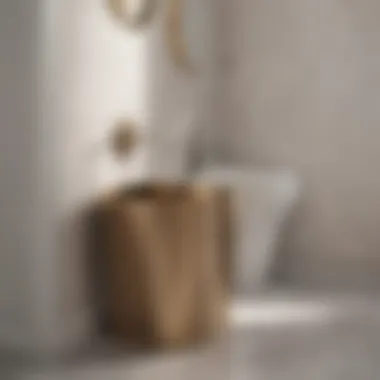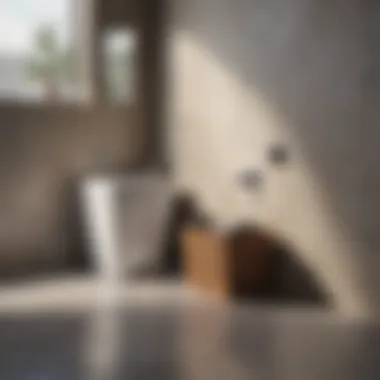Small Bathroom Wastebaskets: Functionality and Style


Intro
In modern home design, even the smallest elements can significantly impact both functionality and aesthetics. One such element is the bathroom wastebasket. While often overlooked, a small bathroom wastebasket plays a crucial role in maintaining cleanliness and order. It can also enhance the visual appeal of the space. As bathrooms evolve into serene sanctuaries, understanding the feasibility of different wastebasket options becomes essential.
This discussion will explore various aspects that contribute to the effective integration of small wastebaskets in contemporary bathrooms. From material choices to design considerations, each factor influences the overall experience of the user. Throughout this article, we aim to provide insights that aid homeowners and designers alike.
Current Trends
Color Palettes
The choice of color in bathroom wastebaskets is no longer limited to basic white or black. Contemporary designs embrace an array of colors that harmonize with bathroom decor. Soft pastels, rich jewel tones, and earthy hues are now popular selections. Notably, colors like sea foam green and muted terracotta can bring warmth and personality to a bathroom. Additionally, metallic finishes and matte textures allow for a sophisticated touch, helping the wastebasket blend seamlessly with other bathroom fixtures.
Popular Styles
When it comes to styles, simplicity and elegance reign supreme. Minimalistic designs are trendy, prioritizing sleek lines and functional shapes. Some homeowners prefer cylindrical wastebaskets that complement rounded sinks and fixtures, while others opt for sharp-edged containers that fit into modern geometry.
The material of wastebaskets is vital as well. Finish choices include stainless steel, which offers durability and a contemporary vibe, or wicker, which can provide a touch of rustic charm. Each choice has its unique advantage, enhancing either the look or the functional aspect of the wastebasket.
Visual Ideas
Gallery of Styled Bathrooms
The presentation of a bathroom can vary greatly based on the selection of wastebasket. For a more defined vision, consider how the wastebasket integrates into various styled settings:
- Spa-like bathrooms can use large baskets made of natural materials.
- Urban settings may benefit from sleek metal options that enhance modern decor.
- Family bathrooms might require more playful designs that still remain functional.
Selecting the right wastebasket adds more than just utility; it contributes to the overall theme.
Before-and-After Transformations
Changes can be significant with the introduction of a new wastebasket. For example, swapping a bulky plastic bin for a designer metal option can uplift the entire room's atmosphere. Similarly, a well-situated wastebasket can help declutter counter space, aligning with minimalistic principles.
"The wastebasket, though a small detail, is an essential part of bathroom design. Its presence can transform a cluttered space into an area of calm efficiency."
Understanding the Importance of Wastebaskets in Small Bathrooms
In any bathroom, especially smaller ones, the role of a wastebasket cannot be underestimated. A well-chosen wastebasket serves both practical and aesthetic functions, addressing the needs of both efficiency and style. The functional necessity of these items is clear; they offer a dedicated spot for disposing of waste, contributing to a cleaner space. In the modern home, where bathrooms are trending toward more compact designs, it becomes even more critical to select wastebaskets that fit seamlessly into the available space while still being accessible.
Moreover, as trends shift toward less clutter and more minimalist designs, the aesthetic value of wastebaskets must also be factored in. A wastebasket should enhance the decor rather than detract from it. Hence, choosing a basket that complements the bathroom's theme can elevate the overall visual experience of the space.
"Interior design is about making things functional before they are beautiful."
Additionally, selecting the right size and style helps to ensure that the wastebasket respects the limited space while providing sufficient capacity. When small bathrooms lack a wastebasket that blends in or serves a unique aesthetic purpose, it can disrupt the harmony of the environment, making it look cramped or chaotic. Therefore, a careful consideration of both functionality and style is paramount.
Types of Small Bathroom Wastebaskets
Understanding the different types of small bathroom wastebaskets is essential for homeowners wishing to achieve both function and style. Choosing the right model can significantly enhance a bathroom's organization while still reflecting personal taste. In modern spaces, wastebaskets need to blend seamlessly into the environment, maintaining not only utility but also a certain aesthetic appeal.
Conventional Models
Conventional wastebaskets are perhaps the most familiar option in residential bathrooms. These models are often constructed from accessible materials like plastic, which makes them lightweight and easy to maneuver. Their straightforward designs allow them to fit into modest spaces without any fuss, providing a basic solution for waste disposal.
When selecting a conventional model, consider size and height, as these factors can greatly impact usability. A smaller design is generally more suitable for compact bathrooms, ensuring that it does not take up unnecessary space. Moreover, these models could be available in a variety of colors and finishes, allowing for a degree of customization that can enhance the overall decor. However, be aware that simpler designs often lack additional functionality, which may be a consideration for those seeking more advanced features.
Sensor Operated Bins


Sensor operated bins usher in a level of convenience that traditional models cannot match. These wastebaskets use motion sensors to detect when an individual is near, allowing the lid to open automatically. This feature is particularly useful in high-traffic bathrooms where users may not want to touch surfaces that can harbor germs.
The design of sensor operated bins can vary, providing options from sleek modern finishes to more traditional aesthetics, accommodating diverse tastes. While they may come at a higher price point than standard models, the advantages can justify the investment for many homeowners. They reduce the risk of odor escape as the lid closes automatically, thus maintaining a fresher environment. Additionally, they often feature removable inner bins, which simplifies cleaning. However, consider that they require adequate battery power or a direct electrical source.
Baskets with Lids
Baskets with lids present another practical option for small bathrooms. The addition of a lid serves essential functions—primarily, it helps to contain odors and keeps the contents out of sight. This type can take on various forms, including hinged or removable lids, catering to preference and usability needs.
Moreover, lids can also add an element of design. For instance, a basket with a chic wooden lid might elevate the decor while contributing to the overall theme of the bathroom. They are easy to clean, especially if the materials used are water-resistant. On the downside, the presence of a lid may require an extra step to access the wastebasket, which could deter some users, especially in busy households.
Ultimately, the choice among these types of wastebaskets should consider personal lifestyle, aesthetic preferences, and functional needs. Thoughtfully selecting a wastebasket can contribute to a well-organized and visually pleasing bathroom space.
Material Choices for Wastebaskets
Selecting the right material for a small bathroom wastebasket is crucial for functionality as well as style. The material directly influences the durability, ease of cleaning, and overall aesthetic appeal. In contemporary spaces, where every design detail matters, the choice of material can either enhance or detract from the overall decor. Understanding the nuances of various materials can lead to smarter choices that align with both practical needs and design aspirations.
Plastic Options
Plastic wastebaskets are among the most common and affordable choices for smaller bathrooms. They are lightweight and flexible, making them easy to move and clean. Additionally, this material offers a wide range of colors and designs, which can complement or contrast with the bathroom scheme effectively.
Another notable advantage is the ease of maintenance. A simple wipe-down with cleaning wipes or a damp cloth will suffice, preventing germs and odors from building up. However, it is essential to choose high-quality plastic to ensure longevity. Some cheaper alternatives may become brittle over time.
Metal Baskets
Metal wastebaskets present a more sophisticated touch to bathroom decor. Stainless steel is a favorable choice due to its resistance to rust and corrosion, which is particularly important in humid environments.
Metal baskets often come in sleek designs that can align well with modern or industrial-themed bathrooms. They are also generally more durable than plastic options and can withstand rough handling without significant wear. However, they might require more frequent cleaning due to potential fingerprint marks and water spots.
Natural Materials
Natural materials, such as bamboo or wicker, can add warmth and a touch of nature to small bathrooms. These materials often provide an organic feel that can be soothing in a typically utilitarian space.
While aesthetically pleasing, care must be taken to protect natural materials from moisture, as they can rot or warp when exposed excessively to water. Choosing natural materials often indicates a preference for sustainability, aligning with environmentally conscious choices. Despite the potential for wear and tear, proper maintenance can enhance their lifespan significantly.
A carefully chosen wastebasket not only serves its function but also contributes to the overall harmony of the bathroom environment.
Design Considerations
In the realm of modern bathroom design, design considerations for wastebaskets cannot be overlooked. These elements go beyond mere aesthetics; they influence how well a space functions and feels. When selecting a small bathroom wastebasket, several specific aspects come into play, including color coordination, style compatibility, and space-saving designs. Each of these facets helps one reflect personal taste while also optimizing limited space, thereby enhancing the overall utility of the bathroom.
Color Coordination
Color coordination is essential when it comes to integrating a wastebasket into a bathroom environment. The wastebasket should not clash with existing colors or themes, as it occupies valuable real estate in a small area. For instance, a solid white wastebasket may work seamlessly in a monochromatic bathroom, while a vibrant patterned one might add a pop of personality to a neutral space. Considerations should include:
- Complementary Colors: Choose a wastebasket that harmonizes with the color palette used in tiles, linens, and décor.
- Contrast: Opt for contrasting colors to make the wastebasket a focal point, without overwhelming the space.
- Finishes: Glossy, matte, or textured finishes can also affect how color is perceived and should be selected with caution.
The goal is to create a balanced look that enhances rather than disrupts the bathroom's design aesthetic.
Style Compatibility
Style compatibility is critical in ensuring that the wastebasket aligns with the overall theme of the bathroom. Various design styles call for different approaches:
- Contemporary: For modern designs, opt for sleek, minimal shapes and materials, such as stainless steel or matte plastic.
- Traditional: A wicker or ceramic basket might better suit a traditional bathroom.
- Eclectic: Mixing styles can be encouraged, but a rule of thumb is to maintain at least one unifying factor, be it color, texture, or form.
Ensuring that the wastebasket complements its surroundings not only augments the décor but also shows thoughtfulness in design.


Space-Saving Designs
In small bathrooms, choosing a wastebasket that utilizes space wisely is imperative. Space-saving designs enhance functionality without causing clutter. Some features to consider include:
- Slim Profiles: Wastebaskets with a narrow width can fit into tight corners or gaps, making them unobtrusive yet accessible.
- Wall-Mounted Options: These bins are excellent for freeing up floor space while providing convenient disposal solutions.
- Multi-functional Use: Some designs allow the wastebasket to serve additional purposes, such as holding magazines or bathroom essentials, thus reducing the number of items in the space.
A well-chosen wastebasket that observes these design considerations can significantly increase the bathroom's usability while contributing to a cohesive aesthetic—making it not just a practical item, but also an element that ties the decor together.
Sizing and Dimensions
Understanding the sizing and dimensions of small bathroom wastebaskets is crucial for ensuring they fit seamlessly into contemporary spaces. The right size influences not only the aesthetic but also the functionality of a bathroom. A wastebasket that is too large can overwhelm a small bathroom, while one that is too small may not be practical for everyday use. The goal is to find the right balance, allowing the wastebasket to serve its purpose without dominating the space.
Standard Sizes for Smaller Bathrooms
Standard sizes for small bathroom wastebaskets typically range from about 10 to 13 gallons. This capacity is suitable for personal or general bathroom waste, such as tissues, hygiene products, and small packaging. The height often varies between 20 to 24 inches, which fits well under most sink counters or beside the toilet.
A common design is the rectangular or round bin. When choosing a bin size, consider the area available. For instance, a narrow model can easily slide beside a toilet without occupying much space.
Some common dimensions include:
- Height: 20 to 24 inches
- Width: 10 to 12 inches
- Depth: 8 to 10 inches
These standard sizes provide a good balance between capacity and efficient use of space.
Custom Dimensions
For those needing something more tailored, custom dimensions offer flexibility. This approach requires measuring the available space carefully to ensure a perfect fit. Custom wastebaskets can be designed to complement the bathroom’s unique decor or specific layout.
Key considerations when seeking custom dimensions include:
- Measuring Space: Take accurate measurements. Consider areas around toilets, sinks, and cabinets.
- Shape Preferences: Decide whether a round, rectangular, or even square shape fits better.
- Functionality Needs: Consider what kind of waste will be placed in the basket. Larger or wider bins may be necessary for busy households.
Customization can yield aesthetic advantages too. A wastebasket that aligns perfectly with bathroom fixtures enhances the overall look. Thus, investing time in sizing and dimensions pays off both functionally and visually.
Choosing the right size of a wastebasket can transform a small bathroom, making it more organized and practical for everyday use.
Optimal Placement Strategies
Placement of small bathroom wastebaskets might seem mundane, but it carries significant weight in functional design. The correct positioning can enhance accessibility and maintain cleanliness, contributing to an overall organized space. When homeowners consider optimal placement strategies, it leads to improved user experience. Finding the right location requires a balance between visibility and convenience without compromising the aesthetic appeal of the bathroom.
Near Toilets
Positioning the wastebasket near the toilet serves multiple purposes. For one, it allows for easy disposal of items like sanitary products, which is a crucial aspect for many users. The convenience factor is paramount; when the wastebasket is nearby, users are more likely to utilize it rather than leaving waste in unwanted places. This strategic placement also encourages better hygiene by reducing clutter and assisting in waste management. Homeowners should consider accessibility when placing the bin. Here, a foot-operated bin may provide added convenience, allowing for hands-free use.
Close to Sinks
Another vital location for wastebaskets is near sinks. Many bathroom tasks generate waste, such as tissue, packaging from soaps, or small paper towels. Having a wastebasket within arm’s reach of the sink promotes more responsible disposal practices. Self-assured accessibility means that tasks, like cleaning the face or drying hands, can remain tidy. Additionally, consider a design that complements the sink area. For example, a wastebasket made of similar material as the sink can create a cohesive look while emphasizing functionality.
Integrated into Cabinets
Integrating wastebaskets within bathroom cabinets offers a sophisticated solution for those who prefer a minimalist appearance. This hidden placement keeps the waste out of view, aligning with a clean design ethos. Rotating drawers or pull-out bins can make waste disposal efficient while preserving the bathroom’s aesthetic. Moreover, this method of integration is especially useful for smaller spaces where floor area is essential. When choosing this option, ensure the materials are resilient to moisture, as bathroom conditions may be less forgiving.
Proper placement of wastebaskets in bathrooms can revolutionize both functionality and design, fulfilling practical needs while promoting organized, clutter-free living spaces.
Sustainability Considerations


Sustainability plays a significant role in modern design, especially in small bathroom wastebaskets. Integrating sustainable elements contributes to environmental conservation and aligns with contemporary values among homeowners. Utilizing eco-friendly materials and practices not only reduces waste but also enhances the aesthetic value of the space. Homeowners are increasingly seeking solutions that minimize their carbon footprint and promote a healthier lifestyle.
By focusing on sustainability in the choice of wastebaskets, individuals can make conscious decisions that reflect their values. This approach promotes awareness of the environmental impact and encourages responsible consumption.
"Sustainable practices in home design can influence everyday choices, enhancing living environments while preserving resources for the future."
When selecting a wastebasket, considering the materials and their lifecycle is crucial. Homeowners should evaluate recyclable options and industrial processes involved in their manufacture. This careful consideration fosters a greater understanding of sustainability and its benefits.
Recyclable Materials
Recyclable materials play a crucial role in diminishing the environmental impact of small bathroom wastebaskets. These materials can be processed and reused, thus reducing waste in landfills. Common recyclable materials for wastebaskets include various types of plastics, metals, and even certain composites. Selecting a wastebasket made from recycled materials can significantly enhance the overall sustainability of your bathroom.
Here are a few benefits of opting for recyclable materials:
- Reduced Environmental Footprint: Less waste produced and decreased resource extraction.
- Quality Assurance: Many recyclable materials meet high durability standards.
- Encouragement of Recycling Culture: Supports societal efforts to implement effective recycling programs.
Consumers should prioritize wastebaskets by brands committed to using eco-friendly, recyclable materials. This practice not only fosters a sustainable lifestyle but also sets an example for responsible consumerism within the household.
Biodegradable Liners
Biodegradable liners serve as an extension of sustainability practices in small bathrooms. Unlike traditional plastic liners that can persist for hundreds of years, biodegradable liners are designed to break down over time. This feature significantly reduces the overall waste generated in bathrooms, making it a better choice for environmentally-conscious households.
Some key points regarding biodegradable liners include:
- Natural Decomposition Process: These liners break down through natural elements, returning to earth without harming ecosystems.
- Variety of Materials Available: Options include paper, cornstarch, or other plant-based products.
- Enhanced Convenience: Many biodegradable liners are designed to fit standard wastebasket sizes, offering ease of use without compromising on functionality.
The use of biodegradable liners complements the sustainable efforts reflected in selecting wastebaskets, showcasing a comprehensive approach to responsible living in modern spaces. Households can create an atmosphere that supports sustainability while improving the overall functionality of their bathrooms.
Maintenance and Care
Maintaining a small bathroom wastebasket is a crucial element that can significantly affect both hygiene and the overall environment of the space. Regular maintenance ensures that the wastebasket remains functional and visually appealing.
Cleaning Recommendations
To keep a wastebasket in optimal condition, it is essential to establish a regular cleaning routine. Here are some actionable tips:
- Regular Emptying: Empty the basket often to prevent overflow and reduce exposure to unpleasant odors.
- Washing: Use warm soapy water and a soft cloth to clean the interior and exterior surfaces at least once a week. If the wastebasket is made of metal or plastic, a mild disinfectant can be applied for deeper cleanliness.
- Drying: After washing, ensure the wastebasket is thoroughly dried to avoid moisture buildup which can lead to mold or foul scents.
- Check for Wear: Regularly inspect for any signs of wear, rust, or damage. Replacing a broken or tarnished unit maintains aesthetic appeal and prevents hygiene issues.
Odor Control Techniques
Odor control is paramount, especially in small spaces where scents can quickly become overwhelming. Here are strategies to keep odors at bay:
- Use of Liners: Invest in durable, odor-resistant liners. These can trap odors and are easier to clean. Choose biodegradable options to enhance sustainability.
- Air Fresheners: Utilize small air fresheners designed for wastebaskets. These can absorb or mask unpleasant smells effectively without being intrusive.
- Lid Functionality: If possible, select baskets with lids. This can dramatically reduce odor escape and also keeps the contents discreetly hidden from view.
- Activated Charcoal: Placing a small bag of activated charcoal or baking soda in the bin can help absorb odors naturally.
By implementing these cleaning and odor control techniques, housewives and homeowners can maintain their small bathroom wastebaskets effectively. It is apparent that a systematic approach to maintenance delivers both practicality and a touch of elegance within the space.
Closure
In the discussion about small bathroom wastebaskets, it is crucial to recognize their role in enhancing both functionality and aesthetic quality in modern bathrooms. These seemingly simple items serve essential purposes that contribute significantly to everyday convenience. A well-chosen wastebasket can streamline waste disposal, maintain order, and even tie a bathroom's design together. Their presence can minimize clutter while providing a neat appearance.
Moreover, considering sustainability is becoming ever more pertinent. Choosing wastebaskets constructed from recyclable materials can positively impact the environment. Such selections not only reflect personal values but also align with broader efforts to create eco-friendly spaces. When homeowners assess the kind of wastebasket that best fits their bathroom, they often consider durability, style, and maintenance ease, creating an intersection of practicality and aesthetics.
Also, the importance of placement cannot be understated. Having wastebaskets in convenient locations ensures they are used consistently, enhancing their functionality further.
Key insights about selecting a wastebasket:
- Match the wastebasket to your bathroom’s decor.
- Prioritize size and functionality suited to the space.
- Look for sustainable options to reduce environmental impact.
Key Takeaways
- Functionality and Design: A well-chosen wastebasket enhances both the efficiency and the aesthetic of a space.
- Sustainability Matters: Opting for eco-friendly materials is not only beneficial for the environment but also echoes modern values in home design.
- Effective Placement: Strategic positioning of wastebaskets increases their usage, promoting cleanliness and organization in small bathrooms.



